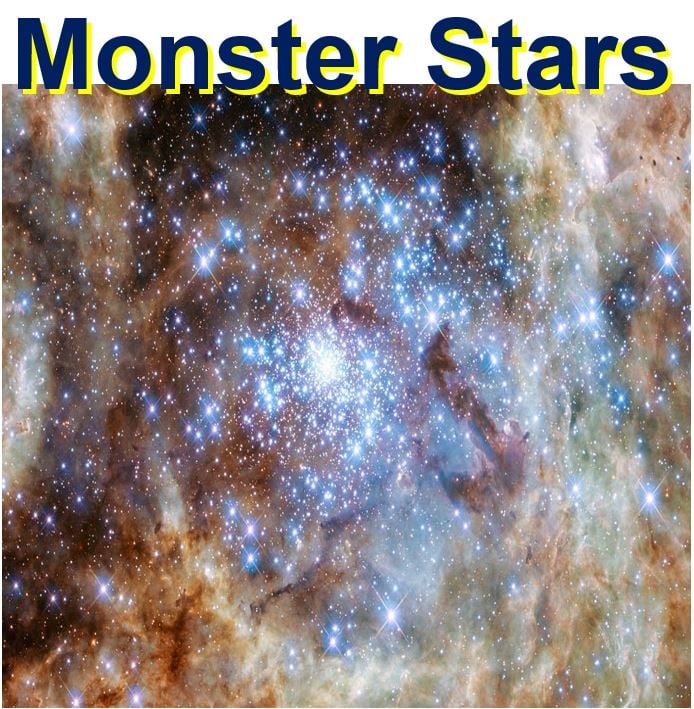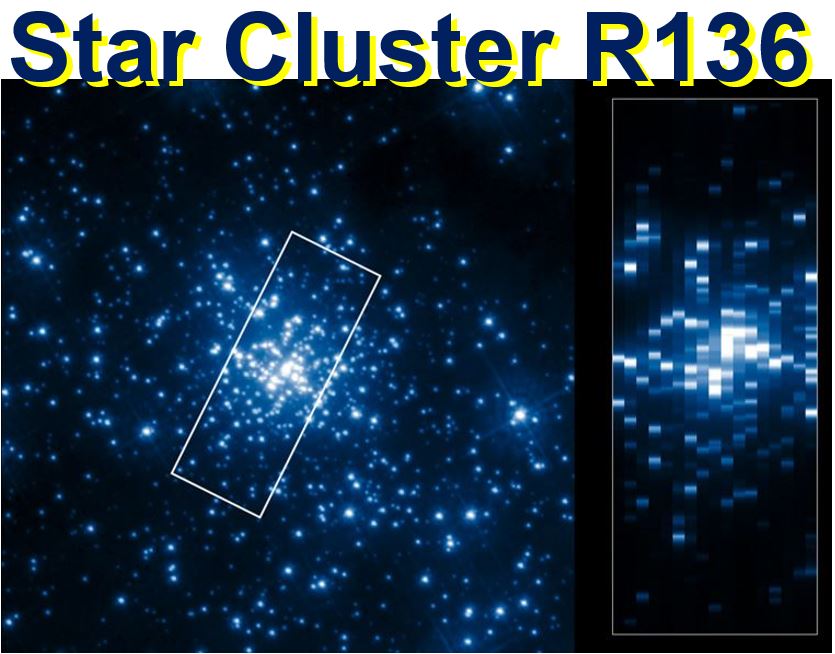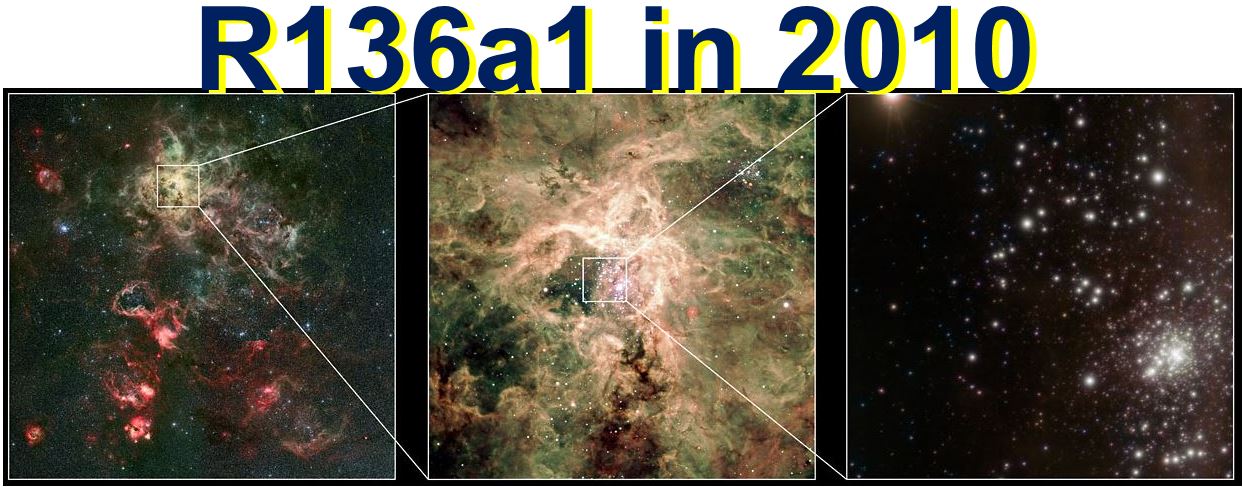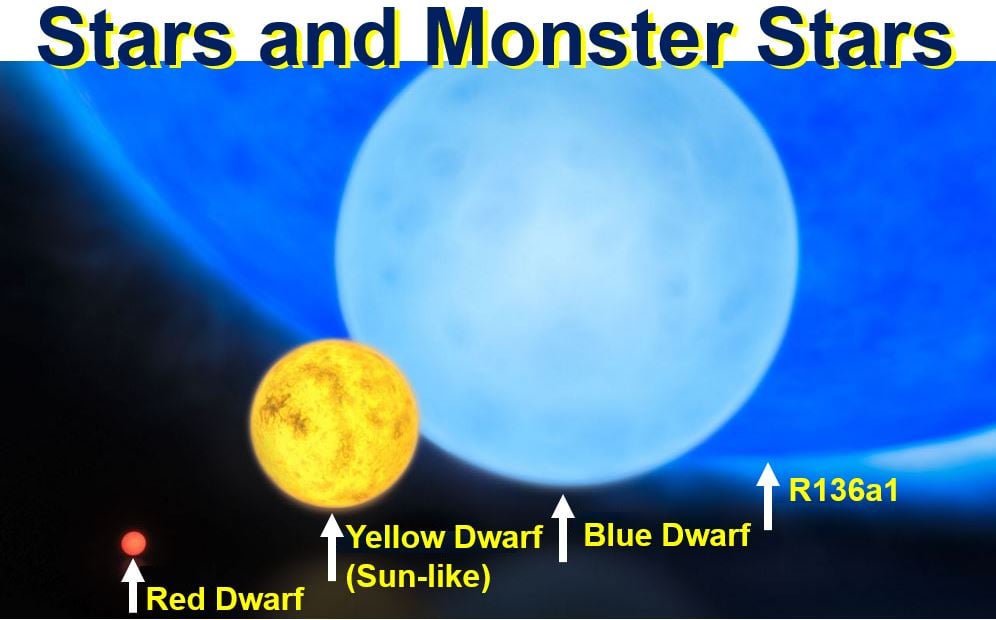Nine monster stars, which are more than 100 times the mass of our Sun each, have been identified so far by an international team of scientists led by the University of Sheffield. The monster-star cluster, called R136, contains the biggest sample of very massive stars spotted to date and has changed how we believe these goliaths are formed.
The scientists combined images taken with the Wide Field Camera 3 (WFC3), NASA/ESA’s Hubble Space Telescope’s last and most technologically advanced instrument to take images in the visible spectrum, with the unprecedented ultraviolet resolution of STIS (Space Telescope Imaging Spectrograph), to effectively dissect the juvenile star cluster in ultraviolet for the first time.
By astronomical standards, R136 covers a relatively small area of just a few light-years. It is located in the Tarantula Nebula within the Large Magellanic Cloud, which is approximately 170,000 light-years from Earth.
 Star Cluster R136 – where nine monster stars with masses of more than 100 times the mass of the Sun have been identified. (Image: Hubble Space Telescope)
Star Cluster R136 – where nine monster stars with masses of more than 100 times the mass of the Sun have been identified. (Image: Hubble Space Telescope)
Many giant stars in R136
This young cluster is host to several very massive, luminous and hot stars whose energy is mainly radiated in ultra violet – hence the reason the scientists probed the cluster’s ultraviolet emission.
The researchers wrote about their study and findings in the scientific journal Monthly Notices of the Royal Astronomical Society (citation below).
Not only did the team find nine very massive stars with more than 100 times the mass of the Sun, they also discovered dozens more with over fifty solar masses.
These stars are extremely massive and also incredibly bright. The nine massive stars have over thirty-million times the brightness of the Sun.
 (Left) The central part of the young star cluster R136 as it can be seen in the ultraviolet. (Right) A pseudo-image, created from the UV spectra collected with the Space Telescope Imaging Spectrograph (STIS). These spectra have been used by scientists to determine the properties of the stars in R136. (Image: Hubble Space Telescope)
(Left) The central part of the young star cluster R136 as it can be seen in the ultraviolet. (Right) A pseudo-image, created from the UV spectra collected with the Space Telescope Imaging Spectrograph (STIS). These spectra have been used by scientists to determine the properties of the stars in R136. (Image: Hubble Space Telescope)
Hubble’s unique capacity
Lead author, Professor Paul Crowther, from the Department of Physics and Astronomy at the University of Sheffield, said:
“Once again, our work demonstrates that, despite being in orbit for over 25 years, there are some areas of science for which Hubble is still uniquely capable.”
“The ability to distinguish ultraviolet light from such an exceptionally crowded region into its component parts, resolving the signatures of individual stars, was only made possible with the instruments aboard Hubble.”
“Together with my colleagues, I would like to acknowledge the invaluable work done by astronauts during Hubble’s last servicing mission: they restored STIS and put their own lives at risk for the sake of future science.”
Six years ago, Prof. Crowther and colleagues from several countries showed the existence of four stars within R136 – each one had more than 150 times the mass of the Sun. At that time they were surprised by the extreme properties of these stars, because they exceeded the then generally-accepted upper-mass limit for stars.
 Image released in 2010 when four monster stars were discovered, one of them – R136a1 – weighing at birth over 300 times the mass of the Sun, which was twice the accepted limit of 150 solar masses at that time. (Image: Hubble Space Telescope)
Image released in 2010 when four monster stars were discovered, one of them – R136a1 – weighing at birth over 300 times the mass of the Sun, which was twice the accepted limit of 150 solar masses at that time. (Image: Hubble Space Telescope)
The origins of monster stars still a mystery
This latest discovery shows there are five more stars with over 100 solar masses within R136. This has raised new questions regarding the formation of massive stars – their origins have always been a bit of a mystery.
Co-author Saida Caballero-Nieves, a Postdoctoral Associate at the University of Sheffield’s Department of Physics and Astronomy, said:
“There have been suggestions that these monsters result from the merger of less extreme stars in close binary systems. From what we know about the frequency of massive mergers, this scenario can’t account for all the really massive stars that we see in R136, so it would appear that such stars can originate from the star formation process.”
 An artist’s impression showing the relative sizes of young stars, from the smallest red dwarfs, weighing in at about 0.1 solar masses, through low mass yellow dwarfs (includes our Sun), to massive blue dwarfs weighing 8 times more than the Sun, as well R136a1, the 300 solar mass star. (Image: eso.org)
An artist’s impression showing the relative sizes of young stars, from the smallest red dwarfs, weighing in at about 0.1 solar masses, through low mass yellow dwarfs (includes our Sun), to massive blue dwarfs weighing 8 times more than the Sun, as well R136a1, the 300 solar mass star. (Image: eso.org)
The scientists aim to find out where these stars come from and how they were formed, and will carry on analyzing the datasets gathered.
An analysis of new optical STIS images will also help them search for close binary systems in R136, which might produce massive black hole binaries which would eventually merge, producing gravitational waves.
None of the new massive stars discovered beats the record so far – the most massive star we know of in the Universe is estimated to be 300 solar masses.
Citation: “The R136 star cluster dissected with Hubble Space Telescope/STIS. I. Far-ultraviolet spectroscopic census and the origin of He ii λ1640 in young star clusters,” Paul A. Crowther, S.M. Caballero-Nieves, K.A. Bostroem, J. Maíz Apellániz, F.R.N. Schneider, N.R. Walborn, C.R. Angus, I. Brott, A. Bonanos, A. de Koter, S.E. de Mink, C.J. Evans, G. Gr¨afener, A. Herrero, I.D. Howarth, N. Langer, D.J. Lennon, J. Puls, H. Sana & J.S. Vink. Monthly Notices of the Royal Astronomical Society. Compiled using MNRAS LATEX style file v3.0. March 2016.
Video – R136a1 the largest star we know of
